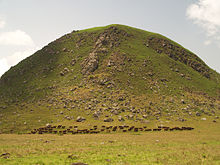Manengouba
| Manengouba | ||
|---|---|---|
| height | 2411 m | |
| location | Cameroon , West (/ Central ) Africa | |
| Coordinates | 5 ° 1 '48 " N , 9 ° 50' 0" E | |
|
|
||
| Type | Stratovolcano | |
| rock | Basalt , trachyte | |
| Last eruption | unknown | |
The Manengouba is an extinct stratovolcano on the border of the provinces Sud-Ouest and Littoral in Cameroon . It reaches a height of 2,411 meters above sea level and is part of the Cameroon Line . The closest cities are Nkongsamba and Melong . To the north of the Manengouba lies the Bambouto massif and to the southwest of the Mount Kupe .
The Manengouba is one of the younger volcanoes of the Cameroon Line, its development began about 1.55 million years ago and is divided into three development phases. In the first phase, the Elengoum, named after its caldera, developed around 1.55 million to 700,000 years ago. After this volcano collapsed and formed its caldera, the Eboga, also called Ebwo, developed about 560,000 years ago. Its caldera was formed around 480,000 years ago and represents the third phase.
The summit region of the volcano is dominated by two calderas , the Eboga (Ebwo) and the Elengoum caldera. The Ebwo Caldera is located at an altitude of 1950 meters and has a diameter of 3 kilometers. At its center are the male and female lakes, which together have a volume of approx. 40 million m³ of water and are used by the local population for medical purposes. Both lakes got their names because of their color, the malelake has a bluish tint and is enriched with calcium , magnesium and sodium . The Femalelake has a greenish color and is rich in bicarbonates . The lower Elengoum caldera is six kilometers in diameter, but is less pronounced due to the erosion of the crater walls. Between the two calderas lies the highest elevation of the Manengouba, on the southern slopes of which a mountain rainforest extends. The summit region of the Manengouba is called Mwaam by the local Bakossi tribe . A total of around 70,000 people live on Manengouba.
The massif of Manengouba has a great ecological importance, since 50% of the Cameroon Mountains in endemic living Anura occur here, including the light-fingered frog erythrogaster Leptodactylodon and Cardioglossa trifasciata . Of the avifauna , around 270 species of birds are at home on the Manengouba. The holotype of the collar shrike ( Telophorus kupeensis ) and the mouse swift ( Schoutedenapus myoptilus ) was found and described for the first time on its wooded mountain slopes . The mammals found at Manengouba include the white-toothed shrew Crocidura manengubae , the African wood shrew Myosorex okuensis and the African climbing mouse Dendromus oreas .
Web links
Individual evidence
- ↑ Armand Kagou Dongmo, Pierre Wandji, André Pouclet, Jean-Paul Vicat, Alain Cheilletz, David Guimolaire Nkouathio, Pavel Alexandrov, Félix M Tchoua: Évolution du mont Volcanologique Manengouba (Ligne du Cameroun); nouvelles données pétrographiques, géochimiques et géochronologiques (PDF document) (French)
- ^ Ivo Melle: 'Ecos' of the Twin Lakes: Ecotourism Development in Mwaam (Muanenguba), Cameroon London Metropolitan University (English)
- ↑ Manengouba volcano on Volcanodiscovery (English)
- ↑ Pulchérie Julie Chakam Tagheu, Pierre Wandji, Jacques-Marie Bardintzeff, Samuel Laminsi: Nature physico-chimique des ressources hydrologiques utiles du stratovolcan Manengouba (Ligne du Cameroun): les lacs de l'Eboga et les sources de Baré (PDF document; 1.2 MB) (French)
- ↑ Birdlife Factsheet CM021 Mont Manengouba (English)
- ↑ Mount Manengouba on Global Wildlife Conservation ( Memento of the original from May 26, 2013 in the Internet Archive ) Info: The archive link was inserted automatically and has not yet been checked. Please check the original and archive link according to the instructions and then remove this notice. (English)



